Oil and Gas Well Drilling and Servicing eTool
Drilling » Drilling Ahead

Drilling ahead means the actual drilling of the well. Specific drilling processes vary, but many of the work hazards are similar. The following generic tasks assume the use of a kelly and rotary table. Other rig designs may include the use of a top drive.
The pipe is unloaded from trucks onto the pipe rack. The floor crew brings pipe from the pipe rack and catwalk, using the catline, air hoist or hydraulic winch, up to the drilling floor and places it in the mousehole. This is done for every connection.
Note: The rig supervisor should hold a pre-job meeting with the crew to review responsibilities and to coordinate the operations to be performed.
Potential Hazards
- Being struck by rolling or falling tubulars.
- Being struck by or caught between tubulars and other objects during movement (for example, being struck by tubulars being tailed into the rig floor).
- Slips, trips, and falls.
Possible Solutions
- Use powered industrial truck (forklift) properly.
- Work the tubulars from the ends from ground level.
- Chock or pin tubulars on the racks properly.
- Level your pipe racks properly.
- Stand clear of suspended, hoisted, or moving loads. Be aware of tubulars or equipment being lifted through the V-door.


Potential Hazards
- Getting struck by falling tubulars due to lifting equipment failure.
Possible Solutions
- Instruct workers in the need for proper use, inspection, and maintenance practices. Before each tour inspect the:
- Wire rope and slings,
- Catline ropes and knots (do not allow a rope to lie in standing water), and
- Chains and hooks.
- Stand clear of suspended, hoisted or moving loads and be aware of your surroundings.
Additional Information
- RP 54. American Petroleum Institute (API), (March 2007). Includes procedures for promotion and maintenance of safe working conditions for employees engaged in rotary drilling operations and well servicing operations, including special services. Applies to rotary drilling rigs, well servicing rigs, and special services as they relate to operations on locations.
- Accident Prevention Guide. International Association of Drilling Contractors (IADC).
- Drilling Technology Series. Petroleum Extension Service (PETEX), University of Texas at Austin.
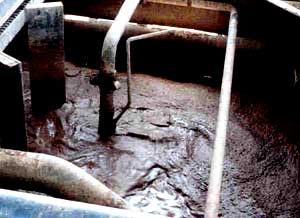


Drilling fluid is an important component in the drilling process. A fluid is required in the wellbore to:
- Cool and lubricate the drill bit,
- Remove the rock fragments, or drill cuttings, from the drilling area and transport them to the surface,
- Counterbalance formation pressure to prevent formation fluids (i.e. oil, gas, and water) from entering the well prematurely (which can lead to a blowout), and
- Prevent the open (uncased) wellbore from caving in.
The mud is monitored throughout the drilling process. A mud engineer and/or the Derrickman may periodically check the mud by measuring its viscosity, density, and other properties.
Potential Hazards
- Burns, or physical injury caused by contact with skin or eyes.
- Being exposed to explosions or violent reactions from chemicals mixed improperly.
- Being exposed to inhalation hazards.
- Receiving strains and sprains.
- Slips, trips and falls.
Possible Solutions
- Ensure workers follow the safe handling procedures found in Material Safety Data Sheets (MSDS). [Example SDS], [29 CFR 1910.1200]
- Wear appropriate personal protective equipment, including, eye and face protection. [29 CFR 1910.132], [29 CFR 1910.133]
- Wear appropriate respiratory protection when handling chemicals and/or mud additives. [29 CFR 1910.134]
- Provide an eyewash station and other appropriate flushing apparatus as recommended by the MSDS. [29 CFR 1910.151(c)]
- Provide adequate ventilation.
- Use proper mixing procedures.
- Use designated containers for mixing certain chemicals (for example, baffled container with lid).
- Substitute less hazardous materials or use pre-mixed mud.
- See General Safety and Health.
Note: Tank cleaning is a high-hazard operation requiring confined space entry procedures, training for personnel, personal protection equipment, and specialized equipment. [29 CFR 1910.146]
#37. Drill Bit
The cutting or boring element used in drilling oil and gas wells. Most bits used in rotary drilling are roller-cone bits. The bit consists of the cutting elements and the circulating element. The circulating element permits the passage of drilling fluid and uses the hydraulic force of the fluid stream to improve drilling rates.†


To start drilling, a surface drill bit is attached to a bottomhole drill collar, which is in turn attached to the kelly. Once made up, the driller lowers the bit through the rotary table and engages the mud pump(s) and checks for leaks and other abnormalities. The driller lowers the drill string and the kelly bushing is set in the rotary drive bushing and the rotary is engaged. The driller then slowly lowers the bit to bottom and begins the drilling operation.
Potential Hazards
- Being struck by the tongs, the make-up chain, or pipe.
- Being caught between collars and tongs, spinning chain, and pipe.
Possible Solutions
- Implement an effective pipe handling, make-up, break-out procedure:
- Stand outside the tong swing radius when breaking pipe.
- Use proper tong latching techniques and use proper hand and finger placement on tong handles.
- Stand clear of the rotary table when it is rotating.
- Use a tail rope on the spinning chain to keep hands away.
Potential Hazard
- Receiving strains and sprains during lifting or controlling movement of drill collars, bit breaker, pipe, and tongs.
Possible Solutions
- Use proper lifting technique.
- Hoist slowly to limit pipe momentum.
- Use mechanical lifting aids such as a rig floor winch.
- Use tail rope to guide as necessary.
Potential Hazards
- Slips, trips, and falls.
Possible Solutions
Potential Hazards:
- Encountering shallow gas.
Possible Solutions:
Additional Information
- Well CAP. International Association of Drilling Contractors (IADC), (2006). Ensures that well control training schools adhere to a core curriculum developed by industry.
#38. Drill Collar
A heavy, thick-walled tube, usually steel, used between the drill pipe and the bit in the drill stem. It is used to put weight on the bit so that the bit can drill.†
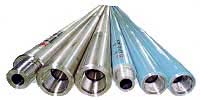
#43. Kelly
The heavy square or hexagonal steel member suspended from the swivel through the rotary table. It is connected to the topmost joint of drill pipe to turn the drill stem as the rotary table turns.†


#51. Rotary Table
The principal component of a rotary, or rotary machine, used to turn the drill stem and support the drilling assembly. It has a beveled gear arrangement to create the rotational motion and an opening into which bushings are fitted to drive and support the drilling assembly.
Note the pipe spinner (in red) on the side of the swivel.†

#44. Kelly Bushing
A device fitted to the rotary table through which the kelly passes. It is the means by which the torque of the rotary table is transmitted to the kelly and to the drill stem. Also called the drive bushing.†
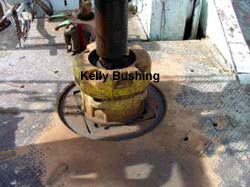
#59. Tongs
The large wrenches used for turning when making up or breaking out drill pipe, casing, tubing, or other pipe; variously called casing tongs, rotary tongs, and so forth according to the specific use. Power tongs are pneumatically or hydraulically operated tools that spin the pipe up and, in some instances, apply the final makeup torque.†


The driller stops the drill string from rotating, and hoists the drill string with the drawworks until the kelly is out of the rotary table. The driller then shuts down the mud pump(s). The floor hands set the slips around the joint of pipe. The tongs are then latched onto the tool joints above and below the connection.
Potential Hazards
- Pinching fingers or other body parts between slips or slip handles and rotary table.
- Experiencing muscle strain from improper lifting technique.
- Pinching fingers when latching the tongs onto the pipe.
Possible Solutions
- Implement effective, safe work procedures for using slips and tongs, which include:
- Proper finger and hand placement on slip handles and tong handles
- Proper stance and slip lifting techniques
- Proper tong latching techniques
Additional Information:
- RP 54. American Petroleum Institute (API), (March 2007).
- Well CAP. International Association of Drilling Contractors (IADC), (2006). Ensures that well control training schools adhere to a core curriculum developed by industry.
- Drilling Technology Series. Petroleum Extension Service (PETEX), University of Texas at Austin.
#36. Drawworks
The hoisting mechanism on a drilling rig. It is essentially a large winch that spools off or takes in the drilling line and thus raises or lowers the drill stem and bit.†
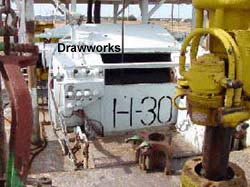
#52. Slips
Wedge-shaped pieces of metal with teeth or other gripping elements that are used to prevent pipe from slipping down into the hole or to hold pipe in place. Rotary slips fit around the drill pipe and wedge against the master bushing to support the pipe. Power slips are pneumatically or hydraulically actuated devices that allow the crew to dispense with the manual handling of slips when making a connection. Packers and other down hole equipment are secured in position by slips that engage the pipe by action directed at the surface.†



The tongs and cathead are used to break out the pipe. Either the rotary table or kelly spinner is used to spin the drill string or kelly to unscrew it from the drill pipe joint.
Potential Hazards
- Being struck by:
- Swinging tongs if the tong dies fail, or the tong counterweight lines were to break.
- The slip handles if the rotary table is used to spin the drill string.
- Reverse backlash of tongs (backbiting) during spinning out operations.
- The tongs if a snub line breaks or the tongs come unlatched.
- A pipe.
Possible Solutions
- Inspect tong dies, counterweight cables, and snub lines thoroughly and prior to each trip.
- Implement an effective spinning out pipe procedure:
- Personnel other than tong operators stand outside the tong swing radius when breaking pipe.
- No one should stand in the red zone (see Diagram 1).
- Use proper tong latching techniques and use proper hand and finger placement on tong handles.
- Stand clear of the rotary table when it is rotating.
- Use special operational procedures when using a high torque connection.
- Maintain good communication between floor crew and driller.
Potential Hazard
- Release of excess drilling mud resulting in skin contact, loss of footing, etc.
Possible Solutions
- Use a mud bucket to direct mud down into the rotary table.
- Close the mud saver valve on the kelly (if present).
Additional Information
- RP 54. American Petroleum Institute (API), (March 2007).
- Accident Prevention Guide. International Association of Drilling Contractors (IADC).
- Drilling Technology Series. Petroleum Extension Service (PETEX), University of Texas at Austin.
#29. Cathead
A spool-shaped attachment on a winch around which rope for hoisting and pulling is wound.†

#45. Kelly Spinner
A device for spinning the drill pipe. Replaces the spinning chain.†


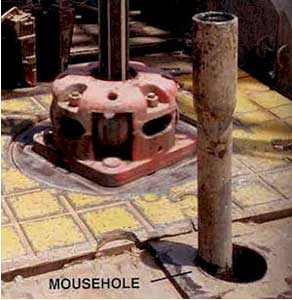
The crew swings the kelly out over the mousehole and stabs it into a new joint of pipe. The driller then spins up the kelly using the kelly spinner or spinning chain and the crew uses tongs to torque the joint.
Potential Hazards
- Being struck or pinched by the kelly.
- Losing footing while swinging the kelly out over the mousehole and stabbing it into a new joint of pipe.
- Being struck by or caught in the spinning chain.
Possible Solutions
- Use proper hand placement.
- Keep the work area around the rotating table clean and clear of mud, ice, snow, debris and other materials that may cause slipping or tripping.
- Inspect chain for broken or distorted links. Chains with the metal reduced by wear at any point less than 90 percent of its original cross section area should be discarded.
- Lubricate and maintain guide rollers to prevent undue wear on the chain or cable.
Additional Information
- Accident Prevention Guide. International Association of Drilling Contractors (IADC).
- Drilling Technology Series. Petroleum Extension Service (PETEX), University of Texas at Austin.
#46. Mousehole
Shallow bores under the rig floor, usually lined with pipe, in which joints of drill pipe are temporarily suspended for later connection to the drill string.†

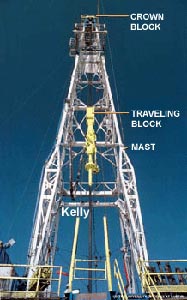
The driller uses the drawworks to raise the kelly and attached joint out of the mousehole.
Potential Hazards
- Being struck by debris or overhead objects if the traveling block runs into the crown block or if the traveling block or swivel hits the derrick.
- Being struck by kelly or pipe.
Possible Solutions
- Install a crown safety device on the drawworks and ensure proper functioning.
- Keep personnel clear of the potential swing path of the kelly and pipe.


The new joint is guided over to the drill hole, the tool joint is doped, and stabbed into the end of the pipe suspended in the rotary table with the slips. The joints are threaded together using the pipe spinner, kelly spinner, or spinning chain. Final torque is provided by the tongs. The drawworks lifts the kelly and attached string to facilitate removal of the slips.
Potential Hazards
- Being struck by:
- Swinging kelly and pipe,
- Tongs if the stabber misses the stump, and
- The jerk or spinning chain.
- Being caught between the swinging pipe and the tongs.
- Being caught between the joint of pipe being stabbed and the stump.
- Getting pinched between tongs or pipe spinner and pipe.
- Slips, trips, and falls.
Possible Solutions
- Never step over a jerk chain and stay clear of spinning chain when a connection is being made.
- Keep hands away from end of stump or inside of pipe.
- Keep feet and legs away from underneath tongs when the pipe is being stabbed.
- Use proper tong latching techniques and hand and finger placement on tong handles.
- Never stand or walk under suspended loads.
- Keep the work area around the rotary table clean and clear of drilling fluids, mud, ice, snow, debris, and other materials that may cause slipping or tripping.
- Inspect chains for worn or damaged links, and replace a chain having a broken or distorted link with the metal reduced by wear at any point less than 90 percent of its original cross section area.
- See Slips, Trips, and Falls.
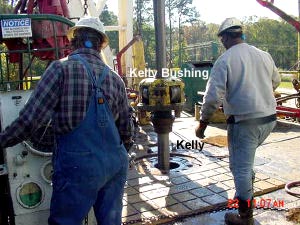
The driller starts the pump and picks up off the slips. The drill crew then removes the slips. The driller lowers the string until the kelly drive bushing engages the master bushing. Once the bushings are in place, the driller begins rotating the drill string, lowers the bit back to bottom, and continues making hole.
Potential Hazards
- Being thrown off the rotary table when engaged.
- Getting caught by loose clothing.
Possible Solution
- Stand clear of the rotary table.

In some cases the operator orders a core sample of the formation for testing. A special core barrel is lowered to the bottom on the drill string and is rotated to cut a core from the formation. This core is brought to the surface and examined in a laboratory.
Potential Hazards
- Being pinched or struck by the core barrel and associated tools during floor operations.
- Being struck by the core as it is removed from the barrel.
- Encountering other hazards similar to those encountered during tripping out/in.
Possible Solutions
- Wear appropriate personal protective equipment.
- Instruct workers in handling and using the special tools required during drill core extraction.






